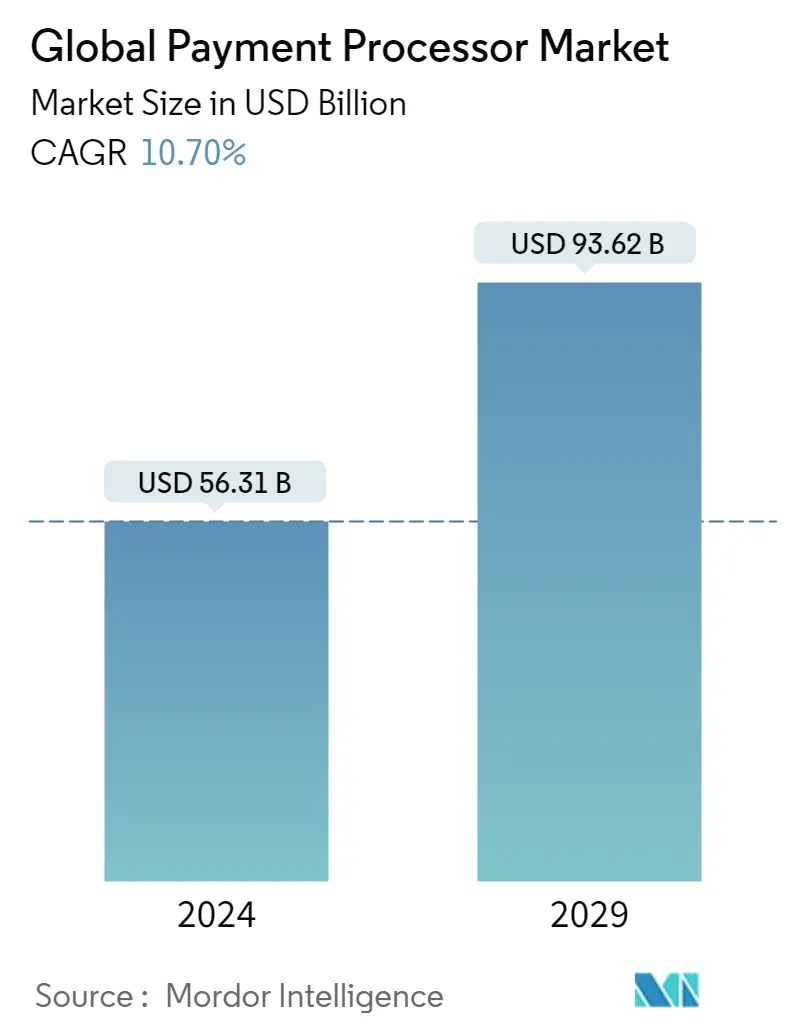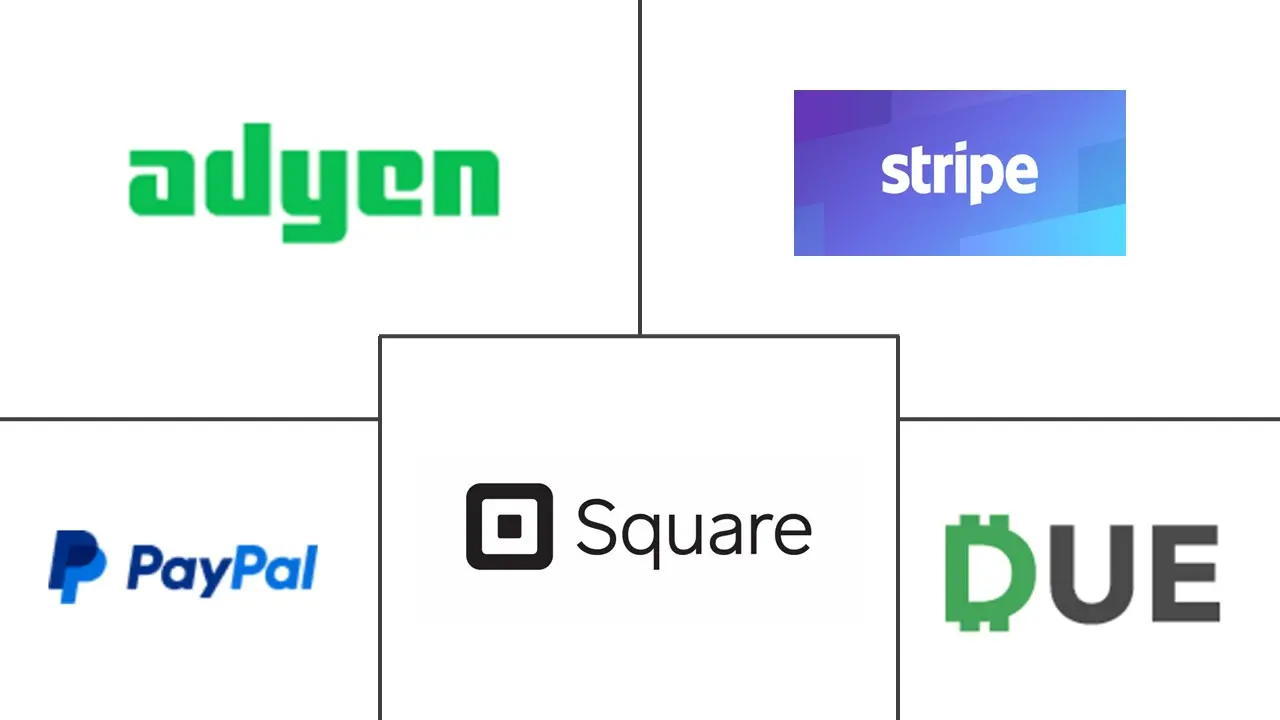Market Size of Global Payment Processor Industry

| Study Period | 2019 - 2029 |
| Market Size (2024) | USD 56.31 Billion |
| Market Size (2029) | USD 93.62 Billion |
| CAGR (2024 - 2029) | 10.70 % |
| Fastest Growing Market | Asia Pacific |
| Largest Market | North America |
Major Players
*Disclaimer: Major Players sorted in no particular order |
Payment Processor Market Analysis
The Global Payment Processor Market size is estimated at USD 56.31 billion in 2024, and is expected to reach USD 93.62 billion by 2029, growing at a CAGR of 10.70% during the forecast period (2024-2029).
The market growth can be attributed to the rising global prevalence of the internet and smartphones. Because of the ease of access to the internet, the use of digital payment processing has increased, resulting in the expansion of the payment processing solutions business.
- The payments landscape globally is changing rapidly due to the increasing enterprises and consumer propensity toward digital transformation, coupled with the high penetration rate of smartphones. The technological advancements in the smartphone industry, the evolution of digital payment methods, and the adoption of POS at retail terminals fuel market growth.
- Several technologies, such as blockchain, IoT, AI, ML, and many more, act as significant catalysts for the market's growth. For instance, IoT increases connectivity and device penetration and stimulates embedded payments, disrupting the payments industry. For certain payment types, distributed ledger technology enables more cost-effective, secure, and in most commercial use cases, fully traceable money movement. When combined with blockchain, embedded IoT systems could function as decentralized credit-card processing platforms. This combination has already eroded the value of plastic cards by enabling a consumer's digital ID as a key for payment execution. Hence, the growth of these technologies is expected to boost the growth of the market studied.
- The growing e-commerce market is further influencing the growth of digital payment methods, stimulating the growth of payment processors globally. With an increase in online shoppers using mobile devices, the demand for mobile payment methods is expected to increase significantly over the coming years.
- The increase in international trade, internationalization of production, and cross-border e-commerce suggest that demand for digital cross-border payments will continue to grow globally. However, digital payments from one country to another might prove to be costlier, slower, and less transparent than domestic payments due to the complexity involved in the procedure. This might hinder the adoption of digital payments for cross-border transactions amongst regional enterprises, especially small and medium-sized businesses.
- Since the outbreak of the COVID-19 pandemic, the demand for digital payments has increased exponentially, owing to the growing demand for contactless payment methods. Even though these payment methods see prominent adoption and growth in Asian countries, the demand is expected to increase worldwide primarily because they are easy and inexpensive to implement. Post-pandemic also, the market is growing rapidly with the increased adoption of digital payments and e-commerce markets across the globe.
Payment Processor Industry Segmentation
The scope of the study analyzes the payments landscape globally to analyze the growth of payment processors across all geographies. A payment processing company acts as a bridge connecting the seller, buyer, and the banks and financial service providers to assist the sellers in accepting the gains made by the buyers and processing the amount to the seller's account while coordinating with the banks and the financial service providers. It accepts payments via different payment methods, such as credit/debit cards, mobile wallets/e-wallets, and many others.
The market covers the emerging trends in payment processing segmented by payment type adopted across different regions studied. The scope of the study is currently focused on key countries in regions such as North America, Europe, Asia-Pacific, Latin America, and Middle East & Africa.
The study also incorporates the impact of the COVID-19 pandemic on the future growth prospect of the market.
The Payment Processor Market is Segmented by Type (Credit Cards, Debit Cards, e-Wallet Transactions) and Geography (North America (United States, Canada), Europe (United Kingdom, Germany, France, Rest of Europe), Asia Pacific (China, India, Japan, South Korea, Rest of Asia Pacific), Rest of the World).
The market sizes and forecasts are provided in terms of value in USD million for all the above segments.
| By Type | |
| Credit Cards | |
| Debit Cards | |
| e-Wallet Transactions |
| By Geography | |||||||
| |||||||
| |||||||
| |||||||
| Rest of the World |
Global Payment Processor Market Size Summary
The Payment Processor Market is experiencing significant growth, driven by the increasing global adoption of digital payment methods and the proliferation of smartphones. The market is evolving rapidly due to the digital transformation trends among enterprises and consumers, alongside technological advancements in payment processing solutions. Innovations such as blockchain, IoT, AI, and ML are acting as catalysts, enhancing connectivity and enabling more secure and efficient payment methods. The rise of e-commerce and cross-border trade further fuels the demand for digital payment processors, although challenges remain in the form of cost and complexity in international transactions. The COVID-19 pandemic has accelerated the shift towards contactless payments, with a lasting impact on the market's expansion.
Regionally, the Asia Pacific leads in the adoption of online transactions, with China and India showing remarkable growth due to widespread smartphone and bank account ownership. Partnerships and collaborations among key players like Visa, Mastercard, and emerging fintech companies are shaping the market landscape, enhancing product offerings and expanding market reach. The market remains highly fragmented, with major players such as PayPal, Stripe, and Square Inc. leveraging strategies like mergers and acquisitions to gain a competitive edge. As digital payment infrastructure continues to strengthen globally, the Payment Processor Market is poised for sustained growth, driven by technological advancements and increasing consumer demand for seamless payment experiences.
Global Payment Processor Market Size - Table of Contents
-
1. MARKET DYNAMICS
-
1.1 Market Overview
-
1.2 Introduction to Market Drivers and Restraints
-
1.3 Industry Attractiveness - Porter's Five Forces Analysis
-
1.3.1 Threat of New Entrants
-
1.3.2 Bargaining Power of Buyers
-
1.3.3 Bargaining Power of Suppliers
-
1.3.4 Threat of Substitute Products
-
1.3.5 Intensity of Competitive Rivalry
-
-
1.4 Industry Value Chain Analysis
-
1.5 Assessment of the Impact of COVID-19 on the Market
-
-
2. MARKET SEGMENTATION
-
2.1 By Type
-
2.1.1 Credit Cards
-
2.1.2 Debit Cards
-
2.1.3 e-Wallet Transactions
-
-
2.2 By Geography
-
2.2.1 North America
-
2.2.1.1 United States
-
2.2.1.2 Canada
-
-
2.2.2 Europe
-
2.2.2.1 United Kingdom
-
2.2.2.2 Germany
-
2.2.2.3 France
-
2.2.2.4 Rest of Europe
-
-
2.2.3 Asia Pacific
-
2.2.3.1 China
-
2.2.3.2 India
-
2.2.3.3 Japan
-
2.2.3.4 South Korea
-
2.2.3.5 Rest of Asia Pacific
-
-
2.2.4 Rest of the World
-
-
Global Payment Processor Market Size FAQs
How big is the Global Payment Processor Market?
The Global Payment Processor Market size is expected to reach USD 56.31 billion in 2024 and grow at a CAGR of 10.70% to reach USD 93.62 billion by 2029.
What is the current Global Payment Processor Market size?
In 2024, the Global Payment Processor Market size is expected to reach USD 56.31 billion.

